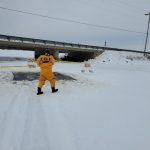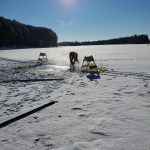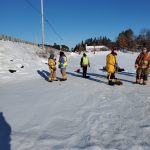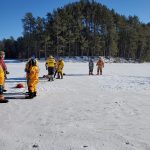Little Rice, Cassian first responders also participated
By Jalen Maki
Tomahawk Leader Editor
LAKE NOKOMIS – The Nokomis Fire Department hosted ice rescue training on Lake Nokomis on Saturday, Jan. 15.
First responders from the Little Rice and Cassian fire departments were also on hand for the exercise.
Temperatures reached -11° during the training, a post on the Nokomis Fire Department’s Facebook page said.
“We train to be confident with the skills required to perform a rescue day or night,” the post stated.
Nokomis Fire Department Chief Don Richert said ice rescue training, also known as cold water rescue training, entails many different rescue options that can only be conducted in a hands-on fashion during the winter months.
Ice rescue is usually needed when conditions are dark, and both verbal and nonverbal communications are necessary. Richert said both forms of communication are practiced.
“If a rescue is being performed within a distance that can be lit up by scene lighting, hand signals are used,” Richert explained. “When the rescue is out of the range of lighting, then verbal communication is needed.”
Richert noted that communication is “also very important for the person in the water, as this is a very traumatic event.”
First responders practice asking the person in the water several questions, such as whether or not they are able to move their hands and fingers and if they can touch the ground with their feet.
“Sometimes the water is not that deep, but due to the event, we forget about some of the easiest things,” Richert said.
First responders also ask the person their name and tell the person their name as part of establishing contact.
“After we obtain some of these answers, we can help make decisions on the rescue,” Richert stated, adding that rescuers sometimes don’t even have to enter the water, “as there are other ways and tools available to us.”
These tools include ladders, pike poles, fire engine hoses, inflatable and pontoon rescue craft, floatable sleds and slings.
Richert said that although first responders spend time practicing with these resources, the majority of the training focuses on having a rescuer in the water.
“Performing this type of rescue is difficult, as the suits that we wear help us stay warm and buoyant, sometimes too buoyant,” Richert said. “Rescuers work hard on keeping their feet down, and it is very hard to perform a rescue floating on your back.”
First responders also practice keeping the incident as controlled as possible, as the rescuer can be inadvertently submerged by the person they are trying to rescue, Richert noted.
The final portion of the training involves removing the patient from the ice. Richert said this is done either by a backboard or a Stokes basket.
“Safety of the patient and the responders is priority one, and we hardly get the ideal location to just walk off,” Richert stated. “Hills, deep snow and possibly just the distance we have all play into what equipment we need to use.”
The department has ice cleats, ropes and pulleys, ATVs and UTVs, “and just downright manpower” at their disposal, and the equipment used must be planned out so the patient can be efficiently moved to a waiting ambulance.
Richert said that multiple departments training together gives first responders the opportunity to become familiar with other departments’ equipment.
“It also gives us a chance to work more closely in a controlled environment, so when that day does come, efficiency and task are already set in place,” Richert stated.




